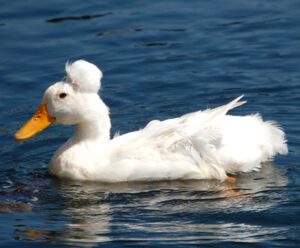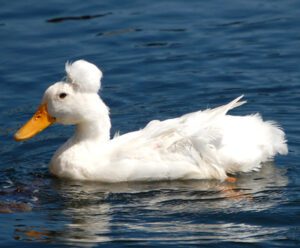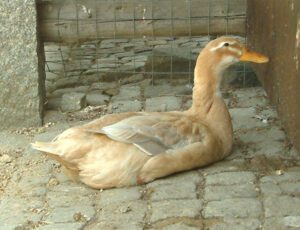The Magpie duck is a lightweight breed of domestic duck developed in the early 20th century. It is raised as a general purpose duck and named for it’s distinctive black and white plumage.
The Magpie duck was developed by Oliver Drake and M.C. Gower-Williams in Wales. It is supposed that the Magpie ducks may have been created from the Belgian Huttegem and the Runner duck, mainly because of their size, plumage pattern and somewhat upright carriage.
Belgian Huttegem was an old Belgian duck breed with possible Runner breed ancestry, which was popular in the duck raising area north of Brussels. And the description of the Huttegem (form old paintings at that time) are remarkably similar to the modern Magpie duck.
In the year of 1963 the breed was first imported to the United States from Great Britain, but didn’t become popular until 1984. The breed is still one of the rarer varieties of domesticated duck.
Magpie duck entered the British Waterfowl Standards in 1926. And was admitted into the American Poultry Association’s Standard of Perfection in 1977.
Magpie Duck Characteristics
According to the American Poultry Association’s Standard of Perfection, the Magpie duck is classed as a lightweight breed of domestic duck. And it is named for it’s distinctive black and white plumage, reminiscent of the coloration of the European Magpie.
It is similar in size and shape as the Khaki Campbell duck, but more substantial. And it is moderately streamlined with a somewhat upright carriage that suggests the Indian Runner duck in it’s ancestral bloodline.
An agitated Magpie duck tends to stand more upright but a relaxed duck is more horizontal. The plumage of the Magpie duck is predominantly white with two large black areas on the back and also on the top of the head.
And the black cap will normally begin to be flecked with white in accordance with the age of the ducks. The black cap may eventually become completely white.
The bill of the Magpie duck is yellow or orange, but turns green in older ducks. Their chest is rounded and the neck is moderately long. Magpie ducks have orange colored legs and feet, but may be mottled.
The drakes have curled feathers on the tail when fully feathered. While the ducks have straight feathers on the tail when fully feathered.
There are many color varieties of the Magpie duck such as Black & White, Blue & White, Chocolate & white, Dun & White. But the Black & White and Blue & White varieties are accepted by the American Poultry Association’s Standard of Perfection.

Average body weight of the Magpie duck is about 2 to 2.7 kg. And the drakes weight about 2.5 to 3.2 kg on average. Photo from Wikipedia.
Uses
The Magpie duck was created as a general purpose breed. They are good layers and also good as a meat duck breed. It is a good exhibition breed also.
Special Notes
If handled regularly, the Magpie duck is usually a calm and docile duck breed. It become a friendly breed and become easy to manage if handled regularly from a young age.
The Magpie ducks are very active foragers and will graze and hunt for a sizable portion of their feed from grass, seeds, insects and aquatic life. While foraging, they consume and eagerly search for slugs, snails and insects.
So the large scale Magpie duck farmers find these ducks effective for eliminating liver fluke infestations. These ducks are among the good egg laying duck breeds, and lay between 220-290 eggs per year. Their eggs are large and white in color.
Meat of these ducks is of gourmet quality and the carcasses will pick cleanly because of their light colored under-belies. The breed is very hardy, strong and long lived.
Average lifespan of these ducks is between 9 and 12 years. Review full breed profile of this duck breed in the chart below.
| Breed Name | Magpie |
| Other Name | None |
| Breed Purpose | Meat, Eggs, Exhibition |
| Special Notes | Active, Calm, Docile, Excellent Foragers, Friendly |
| Breed Class | Light |
| Broodiness | Average |
| Drake | 2.5 to 3.2 kg |
| Duck | 2 to 2.7kg |
| Climate Tolerance | All Climates |
| Egg Color | White |
| Egg Size | Large |
| Egg Weight | Up to 80 grams |
| Egg Productivity | Medium |
| Flying Ability | Poor |
| Rarity | Rare |
| Varieties | Black & White, Blue & White, Chocolate & white, Dun & White. But the Black & White and Blue & White varieties are accepted by the American Poultry Association’s Standard of Perfection. |
| Country of Origin | United Kingdom |







Is this breed good for raising with chickens?
Yes, it is possible to keep Magpie Ducks with chickens, but careful planning and management are necessary to ensure they coexist harmoniously. Monitor their interactions, provide separate feed and water sources, and maintain a clean and safe environment to promote a successful mixed flock.
Your commitment as well as relationship with your site readers are really very good. You reply to all readers and answer their question. Personally I like this very much. God bless you!
Thank you very much for your honest opinion! Good luck!